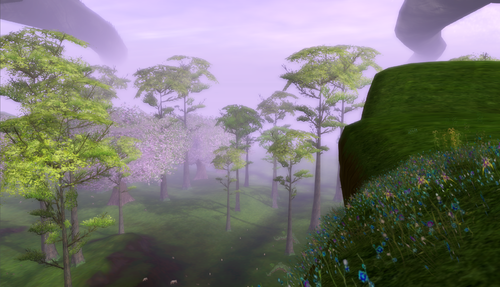The last editing was from Dorothée on 6.06.2020.
Carte des écosystèmes
Espèces communes
Flore
Faune
Contrairement à la flore, la plupart des espèces animales peuvent être observées dans plusieurs écosystèmes:
- Arana, Arma, Bawaab, Bodoc, Bolobi, Capryni, Clopper], Cuttler, Gingo, Gnoof, Goari, Gubani, Horncher, Igara, Izam, Javing, Jugula, Lumper, Madakam, Mektoub, Messab, Najab, Ocyx, Ploderos, Ragus, Rendor, Shalah, Timari, Torbak, Tyrancha, Varinx, Wombaï, Yber, Yelk, Yubo, Zerx ;
auxquels il faut bien évidemment ajouter tous les Kitins:
Dans certains cas, l'aspect extérieur de la faune peut varier sensiblement d'un écosystème à l'autre.
Écosystèmes/Tableau des espèces
Desert

The “Desert” ecosystem is found mainly in the Burning Desert, but also in the Matis country (region of the Hidden Source of the Verdant Heights) and the Zoraï land (The Great Outback, northwest of the Knot of Dementia, in the Witherings. The Aelius Dunes in the Old Lands are also part of it.
Climate
Endemic Species
Flora
- Bodoa, Bothaya, Botoga, Kioraï, Liketim, Loojine, Olansi of the Desert , Olash, Papalexi, Savaniel, Takoda.
- Intelligent Plants: Shooki
Fauna
Forest
The “Forest” ecosystem is found mainly in the Verdant Heights, but also in the Nexus Minor, in the Almati Wood and in the Zorai country (Witherings) as well as on Silan island.
Climate
Endemic Species
Flora
Alinea, Angelio, Arino, Balogna, Bolka, Campana, Crolice, Dorio, Dorotea, Endilweis, Fongice, Fragaria, Gonju, Irena, Iriscea, Maydea, Mill Perle, Pepo, Pocea, Psykopla, Rosae Matia, Rosae Yrkanis, Rotoa, Salin, Salina, Suvue
- See also the Category : Flora of the Forest.
Fauna
- Herbivores : Frippo.
Jungle

The “Jungle” ecosystem is found mainly in the Witherings, but also in the Matis country (Verdant Heights), in particular in the Heretic's Hovel, as well as on the island of Silan.
Climate
Endemic Species
Flora
Alao, Alewo, Alezao, Araj, Arinish, Ba-Che, Batao, Dorao, Faham, Faneng, Fragaria, Fu-Shia, Gonju, Jayazeng, Li-Un, Lu-Tuo, Psykopla, Rosae Matia, Rosae Yrkanis, Salvo, Slaveni, Suvue, Taleng, Vu-Che.
- See also the Category : Flora of the Jungle.
Fauna
- Carnivores : Yetin.
Lakes

The Trykers' country (Aeden Aqueous) is the only one in mainland to host the “Lakes” ecosystem, but the latter is also present on the island of Silan (around the “Shining Lake”) as well as in Lake of Olkern for the part of the Old Lands that is still known.
Climate
Endemic Species
Flora
- Bambú, Bulrush, Cahbacan, Carnuft, Cleitwytt, Cuach, Cúr, Dule, Feadag, Flyner, Gimlet, Liosta, Locharn, Lochmair, Loramn, Magairlín, Manhart, Maërl, Mushfloat, Nadóir, Napell, Olansi of the Lakes, Praic, Rimse, Saccha, Sailgrass, Sailtree, Saltorn, Sparàn, Stol, Suvue, Trumperer, Trysúl, Weedling, Wigweed, Wyttcran.
- Intelligent Pants: Stinga
- See also the Category : Flora of the Lakes.
Fauna
- Carnivores : Cray.
Primes Roots
So is named the unique ecosystem of the depths of Atys, which can be found in the Prime Roots or, in Rangers' country, when entering the Kitins' Lair of Almati Wood.
Climate
Endemic Species
Flora
Amoeba, Bomton, Cocoa, Cokamool, Dziku, Fungao, Fyta, Jiang, Jibung, Lumindra, Ploomweed, Plumash, Plun, Rotoa[1], Soil of Prime Roots, Spone, Toopetz, Topha, Topil.
- Intelligent Pants: Jubla
- See also the Category : Flora of the Lakes.
Fauna
The Prime Roots are the refuge of the most singular fauna of Atys. The species have had to adapt to an ecosystem deprived of daylight and most of the species found there are also present on the bark surface but, paradoxically, they seem to be significantly more vigorous in this environment.
- The Vorax, a particularly dangerous carnivore, seems to be the only species adapted only to Prime Roots.
See Also
- Primes Racines (Ambre détaillée)
- Le bestiaire d'Atys
- Table of Species Ecosystems .
- The Ecosystems Category


